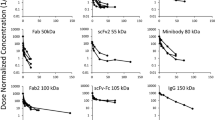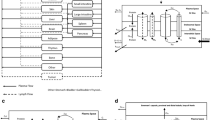Abstract
Domain antibodies (dAbs) are the smallest antigen-binding fragments of immunoglobulins. To date, there is limited insight into the pharmacokinetics of dAbs, especially their distribution into tissues and elimination. The objective of this work was to develop a physiologically-based pharmacokinetic model to investigate the biodisposition of a non-specific dAb construct in mice. Following a single IV administration of 10 mg/kg dummy dAb protein to twenty four female mice, frequent blood samples were collected and whole body lateral sections were analyzed by quantitative whole-body autoradiography. The model is based on the two-pore hypothesis of extravasation where organ-specific isogravimetric flow rates (Jorg,ISO) and permeability-surface area products (PSorg) are expressed as linear functions of the lymph flow rate (Jorg) and the kidney compartment is modified to account for glomerular filtration of dAb. As a result, only Jorg, glomerular filtration coefficient and the combined volume of Bowman’s capsule, proximal and distal renal tubules and loop of Henle were optimized by fitting simultaneously all blood and organ data to the model. Our model captures the pharmacokinetic profiles of dAb in blood and all organs and shows that extravasation into interstitial space is a predominantly diffusion-driven process. The parameter values were estimated with good precision (%RMSE ≈ 30) and low cross-correlation (R2 < 0.2). We developed a flexible model with a limited parameter number that may be applied to other biotherapeutics after adapting for size-related effects on extravasation and renal elimination processes.









Similar content being viewed by others
References
Enever C, Batuwangala T, Plummer C, Sepp A (2009) Next generation immunotherapeutics-honing the magic bullet. Curr Opin Biotechnol 20(4):405–411
Ward ES, Gussow D, Griffiths AD, Jones PT, Winter G (1989) Binding activities of a repertoire of single immunoglobulin variable domains secreted from Escherichia coli. Nature 341(6242):544–546
Holt LJ, Herring C, Jespers LS, Woolven BP, Tomlinson IM (2003) Domain antibodies: proteins for therapy. Trends Biotechnol 21(11):484–490
Dumoulin M, Conrath K, Van Meirhaeghe A, Meersman F, Heremans K, Frenken LG, Muyldermans S, Wyns L, Matagne A (2002) Single-domain antibody fragments with high conformational stability. Protein Sci 11(3):500–515
Hamers-Casterman C, Atarhouch T, Muyldermans S, Robinson G, Hamers C, Songa EB, Bendahman N, Hamers R (1993) Naturally occurring antibodies devoid of light chains. Nature 363(6428):446–448
Nestorov I (2007) Whole-body physiologically based pharmacokinetic models. Expert Opin Drug Metab Toxicol 3(2):235–249
Meno-Tetang GML, Lowe PJ (2005) On the prediction of the human response: a recycled mechanistic pharmacokinetic/pharmacodynamic approach. Basic Clin Pharmacol Toxicol 96(3):182–192
Mošat A, Lueshen E, Heitzig M, Hall C, Linninger AA, Sin G, Gani R (2013) First principles pharmacokinetic modeling: a quantitative study on Cyclosporin. Comput Chem Eng 54:97–110
Garg A, Balthasar J (2007) Physiologically-based pharmacokinetic (PBPK) model to predict IgG tissue kinetics in wild-type and FcRn-knockout mice. J Pharmacokinet Pharmacodyn 34(5):687–709
Baxter LT, Zhu H, Mackensen DG, Jain RK (1994) Physiologically based pharmacokinetic model for specific and nonspecific monoclonal antibodies and fragments in normal tissues and human tumor xenografts in nude mice. Cancer Res 54(6):1517–1528
Ferl G, Wu A, DiStefano J (2005) A predictive model of therapeutic monoclonal antibody dynamics and regulation by the neonatal Fc receptor (FcRn). Ann Biomed Eng 33(11):1640–1652
Davda JP, Jain M, Batra SK, Gwilt PR, Robinson DH (2008) A physiologically based pharmacokinetic (PBPK) model to characterize and predict the disposition of monoclonal antibody CC49 and its single chain Fv constructs. Int Immunopharmacol 8(3):401–413
Heiskanen T, Kairemo K (2009) Development of a PBPK model for monoclonal antibodies and simulation of human and mice PBPK of a radiolabelled monoclonal antibody. Curr Pharm Des 15(9):988–1007
Shah DK, Betts AM (2012) Towards a platform PBPK model to characterize the plasma and tissue disposition of monoclonal antibodies in preclinical species and human. J Pharmacokinet Pharmacodyn 39(1):67–86
Rippe B, Haraldsson B (1994) Transport of macromolecules across microvascular walls: the two-pore theory. Physiol Rev 74(1):163–219
Patlak CS, Goldstein DA, Hoffman JF (1963) The flow of solute and solvent across a two-membrane system. J Theor Biol 5(3):426–442
Barrett PH, Bell BM, Cobelli C, Golde H, Schumitzky A, Vicini P, Foster DM (1998) SAAM II: simulation, analysis, and modeling software for tracer and pharmacokinetic studies. Metabolism 47(4):484–492
Chay SH, Pohland RC (1994) Comparison of quantitative whole-body autoradiographic and tissue dissection techniques in the evaluation of the tissue distribution of [14C]daptomycin in rats. J Pharm Sci 83(9):1294–1299
Venturoli D, Rippe B (2005) Ficoll and dextran vs. globular proteins as probes for testing glomerular permselectivity: effects of molecular size, shape, charge, and deformability. Am J Physiol Renal Physiol 288(4):F605–F613
Şimşek N, Altunkaynak BZ, Ünal D, Can S, Malkoç I, Üna B (2009) A stereological and electron microscopic study of the development of the nephron in prenatal and postnatal. Eurasian J Med 41(2):75–79
Potter RF, Groom AC (1983) Capillary diameter and geometry in cardiac and skeletal muscle studied by means of corrosion casts. Microvasc Res 25(1):68–84
Levick JR, Michel CC (2010) Microvascular fluid exchange and the revised Starling principle. Cardiovasc Res 87(2):198–210
Jones H, Mayawala K, Poulin P (2012) Dose selection based on physiologically based pharmacokinetic (PBPK) approaches. AAPS J 15(2):377–387
Michel CC, Curry FE (1999) Microvascular permeability. Physiol Rev 79(3):703–761
Bundgaard M (1984) The three-dimensional organization of tight junctions in a capillary endothelium revealed by serial-section electron microscopy. J Ultrastruct Res 88(1):1–17
Kedem O, Katchalsky A (1958) Thermodynamic analysis of the permeability of biological membranes to non-electrolytes. Biochim Biophys Acta 27(2):229–246
Hron J, Neuss-Radu M, Pustějovská P (2011) Mathematical modeling and simulation of flow in domains separated by leaky semipermeable membrane including osmotic effect. Appl Math 56(1):51–68
Qi Z, Breyer MD (2009) Measurement of glomerular filtration rate in conscious mice. Methods Mol Biol 466:61–72
Drickamer L (1995) Rates of urine excretion by house mouse (Mus domesticus): differences by age, sex, social status, and reproductive condition. J Chem Ecol 21(10):1481–1493
Rippe B, Haraldsson B (1987) Fluid and protein fluxes across small and large pores in the microvasculature. Application of two-pore equations. Acta Physiol Scand 131(3):411–428
Acknowledgments
Valeriu Damian-lordache and Thuy Tran from GlaxoSmithKline for their useful comments on the manuscript
Conflict of interest
Armin Sepp, Alienor Berges, Andrew Sanderson, and Guy Meno-Tetang are all employees of GlaxoSmithKline Plc.
Author information
Authors and Affiliations
Corresponding author
Electronic supplementary material
Below is the link to the electronic supplementary material.
Rights and permissions
About this article
Cite this article
Sepp, A., Berges, A., Sanderson, A. et al. Development of a physiologically based pharmacokinetic model for a domain antibody in mice using the two-pore theory. J Pharmacokinet Pharmacodyn 42, 97–109 (2015). https://doi.org/10.1007/s10928-014-9402-0
Received:
Accepted:
Published:
Issue Date:
DOI: https://doi.org/10.1007/s10928-014-9402-0




